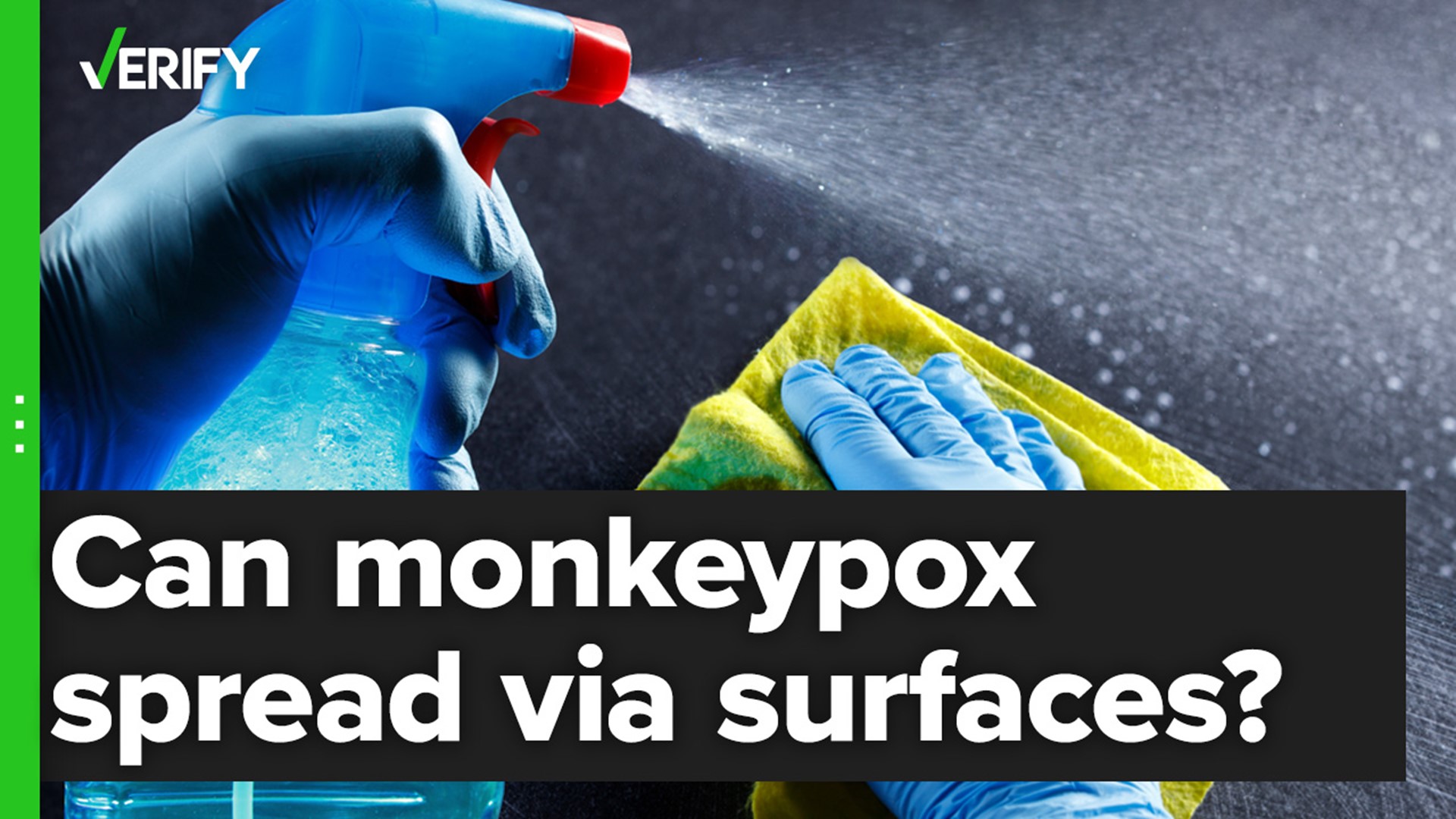With monkeypox cases on the rise in the United States, the federal government has declared a public health emergency to bolster the response to the outbreak that has infected more than 7,500 Americans as of Aug. 5.
Online searches show many people are wondering how monkeypox spreads. Several VERIFY viewers, including Becki and Rob, have asked us whether the virus can be transmitted by touching surfaces that have come in contact with a person who has monkeypox.
THE QUESTION
Can monkeypox spread by touching contaminated surfaces?
THE SOURCES
- Centers for Disease Control and Prevention (CDC)
- Environmental Protection Agency (EPA)
- California Department of Public Health
- Scott Roberts, M.D., assistant professor of infectious diseases at the Yale School of Medicine
THE ANSWER
Yes, monkeypox can spread by touching contaminated surfaces, but the current risk is low.
WHAT WE FOUND
Monkeypox transmission primarily occurs through close, personal, often skin-to-skin contact with people who have monkeypox symptoms, such as a rash and sores, according to the CDC and the California Department of Public Health. The virus can also spread by touching objects, fabrics such as clothing, bedding, or towels, and surfaces that have been used by someone with monkeypox.
Many, though not all, cases have been reported among men who have sex with men. But the California Department of Public Health says anyone can get monkeypox after having close physical contact with someone who has the infection, “especially contact with infected lesions, bodily fluids, or other contaminated surfaces.” However, the public health agency says “the current risk of getting monkeypox in the general public is very low.”
“The risk of getting infected through a surface is quite low — it's not zero, but it is low. And so, that risk of a fleeting contact or somebody briefly touching something probably does not lead to enough virus on that surface to infect you if you get exposed,” Scott Roberts, M.D., assistant professor of infectious diseases at the Yale School of Medicine, told VERIFY.
Orthopoxviruses, like monkeypox, can survive in linens, clothing and surfaces, particularly when in dark, cool, and low humidity environments. Roberts says studies are currently ongoing about how long they can survive on surfaces where they're still viable and can infect somebody. But, he and the CDC both say these viruses are sensitive to many disinfectants.
“This virus is easily killed, so common disinfectants that we use, such as alcohol wipes or Lysol wipes, very easily kill the monkeypox virus,” Roberts said.
The Environmental Protection Agency (EPA) shares a list of disinfectants that may work to kill the monkeypox virus on surfaces on its website. This list includes regular household cleaning supplies that contain bleach, alcohol, and hydrogen peroxide.
The CDC says a person with monkeypox can spread it to others from the time symptoms start until the rash has fully healed and a fresh layer of skin has formed. The illness typically lasts two to four weeks.
There are ways to protect yourself against monkeypox, according to the CDC, including the following:
Avoid close, skin-to-skin contact with people who have a rash that looks like monkeypox (can initially look like pimples or blisters and may be painful or itchy.
Do not touch the rash or scabs of a person with monkeypox.
Do not kiss, hug, cuddle or have sex with someone with monkeypox.
Avoid contact with objects and materials that a person with monkeypox has used.
Do not share eating utensils or cups with a person with monkeypox.
Do not handle or touch the bedding, towels, or clothing of a person with monkeypox.
Wash your hands often with soap and water or use an alcohol-based hand sanitizer, especially before eating or touching your face and after you use the bathroom.
“I recommend routine precautions for what I myself do every time I go out, which is washing hands before eating and washing hands after touching a lot of contaminated surfaces, like at shared events where you're touching many of the same things,” Roberts said. “I don't think we routinely need to Lysol or disinfect surfaces unless we find new data that suggests monkeypox can survive in the environment for weeks at a time. I do not think that's the case, but if we find more data, then obviously recommendations will change.”
The Associated Press contributed to this report.

